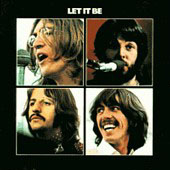|
John, George, and Ringo agreed to this idea, and on January 2, 1969, filming began at Twickenham Film studios. Things did not go well, and George quit on the 10th, only coming back when it was agreed that filming would resume at the new Apple Studio on Saville Row on Jan. 21. Among the tunes performed was the title theme, which Paul had written as a quiet tribute to his mother, Mary, although the "mother Mary" in the song has often been interpreted in a religious light. Paul sings a solo vocal and plays piano. John Lennon, George Harrison and Ringo Starr all play their regular instruments (lead guitar, bass guitar and drums) and Billy Preston, one of the Beatles' old pals from Hamburg, guest stars on organ. Just for fun, the Beatles decided to record a number called "Get Back" on the roof of the building, where giant speakers echoed the sound for miles across London. Complaining neighbors summoned policemen, and in fact, you can see the bobbies in the picture, trying to break up the session and restore the peace. "Get Back" would be released as a single in May 1969, and spend five weeks at the top of the U.S. charts.
Over the weeks that Let It Be was in production, through Jan. 30. 1969, the Beatles were constantly tripping over cameras, lights, and moviemaking people. Paul McCartney kept his composure, but he turned out to be the only one who did. Tempers grew thin, and as days rolled into months, there were wrangles -- even punch-ups -- in the studio. John, by that time, appeared to be perpetually stoned and, to the others' great annoyance, was inseparable from Yoko Ono. He also argued continually with producer George Martin over content, musical style, and even the recording technique. John insisted that Let It Be should be an "honest" album, without overdubs, mixing, or even editing. "I want them to hear us, warts and all," he said. That was the original idea, agreed upon by the whole group, and each of them stood by the "no editing, no overdubs" approach throughout the sessions...not just John. There were just a few overdubs later. Thirty hours of music were put on tape before everyone agreed that that approach was simply not going to work.
In April, 1970 -- as the film Let It Be was nearing completion -- John argued for Phil Spector to work on the tapes for the accompanying soundtrack album. Phil offered to "salvage" the tapes, and the boys -- sick of the whole thing -- gave him their blessing. He immediately went to work, adding strings, horns, celestial choirs -- in short, the whole Phil Spector "Wall of Sound" -- to four songs. The rest benefited from his sharp editing, combining elements of various takes into good final versions, and there were no overdubs on the majority of the tracks. The release of Let It Be was held up until the album, single, and movie could all be ready at the same time. In the interim, three more 45s were issued: "Get Back," "The Ballad of John and Yoko," and a two-sided hit, "Come Together," backed with "Something." There were also two other albums: Hey Jude, a patchwork compilation; and Abbey Road, the Beatles' last collaborative effort. On March 16, 1970, the single version of "Let It Be" was finally released, a year and two months after being recorded. A week later, it was on the charts, and by early the next month, it was the number-one song in America. The timing was perfect, because on April 11, Paul McCartney shocked the world by announcing that he was ready to "let it be." He was leaving the Beatles -- or, in his words, the Beatles left him: "No one wants to be the one to say the party's over." Within a few days, John, Paul, and Ringo confirmed that the group had broken up. "We just got sick of being side men for Paul," said John. "We had fun doin' it, but it's ended, mate." "Let It Be" made a spectacular debut on the Billboard Hot 100 single chart at number six, the highest new entry of all time. Despite its lofty first week position, the single didn't become the Beatles' 19th number one until three weeks later. It was held at bay by Simon and Garfunkel's number one single of 1970, "Bridge Over Troubled Water." A different version of the song appears on the album Let It Be. This is the Phil Spector remix, which includes brass instruments and a choir overdubbed, as well as different arrangements for John and George's guitar playing. The flip side of "Let It Be" was a strange concoction called "You Know My Name (Look Up the Number)." Different sources cite the recording date as 1967 or 1968; what is certain is that the song was considered for an "A" side of a single. At one point, it was scheduled for release as a Plastic Ono Band 45, backed with "What's the New Mary Jane." Assigned a British catalogue number of Apple 1002, the single was withdrawn and John Lennon issued "Instant Karma (We All Shine On)" instead. On May 13, the movie Let It Be opened in New York. Not one Beatle attended the premiere. The album came out soon afterward and, of course, shot to the top of the charts. It spawned a final hit single, "The Long and Winding Road." That too, was number one.
No comments so far, be the first to comment. |


